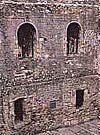![]() Trade
Trade

 Most
trade in Norman England was local and people depended largely on the resources
of their immediate region. However, the period was also one in which the volume
of trade was growing, based largely on the expanding towns amongst which were
many new ones, usually built around one or more market places.
Most
trade in Norman England was local and people depended largely on the resources
of their immediate region. However, the period was also one in which the volume
of trade was growing, based largely on the expanding towns amongst which were
many new ones, usually built around one or more market places.
Trade increasingly involved the use of money and in 1100 there were about fifty English towns with mints. Although the silver penny was the only denomination of coin, pennies were cut into halves and quarters to make small change for day-to-day transactions.
 London,
and other towns with easy access to the sea, continued to be centres of long
distance trade carried in ships and archaeology has shown that wharfage
facilities were improved considerably. Sea-borne voyages may have been risky,
but they were also very profitable. Particularly important were routes to
Flanders, northern France and the Rhineland - the writer William of Malmesbury
commented on the great quantity of goods coming to London from Cologne.
London,
and other towns with easy access to the sea, continued to be centres of long
distance trade carried in ships and archaeology has shown that wharfage
facilities were improved considerably. Sea-borne voyages may have been risky,
but they were also very profitable. Particularly important were routes to
Flanders, northern France and the Rhineland - the writer William of Malmesbury
commented on the great quantity of goods coming to London from Cologne.
 Imports
were largely high-quality consumer goods demanded by the wealthy, and included
fine metalwork, wine, coming increasingly from Gascony after Henry II's marriage
to Eleanor of Aquitaine, and textiles such as silk from Byzantium and Spain.
In addition, the church and crown demanded high quality stone for their great
new cathedrals and palaces. Caen stone was brought from Normandy and exotic
marbles arrived from north Africa. England's exports were largely agricultural
products, especially wool and grain, but also included minerals and it is
recorded that in 1195 Richard I sent 100 tons of tin from Cornwall to La Rochelle
in Brittany.
Imports
were largely high-quality consumer goods demanded by the wealthy, and included
fine metalwork, wine, coming increasingly from Gascony after Henry II's marriage
to Eleanor of Aquitaine, and textiles such as silk from Byzantium and Spain.
In addition, the church and crown demanded high quality stone for their great
new cathedrals and palaces. Caen stone was brought from Normandy and exotic
marbles arrived from north Africa. England's exports were largely agricultural
products, especially wool and grain, but also included minerals and it is
recorded that in 1195 Richard I sent 100 tons of tin from Cornwall to La Rochelle
in Brittany.